National
Anatomy of a botched false flag attack at Detention Camp 52
An analysis of the evidence and the treatment of prisoners at Olenivka indicates a war crime was committed.
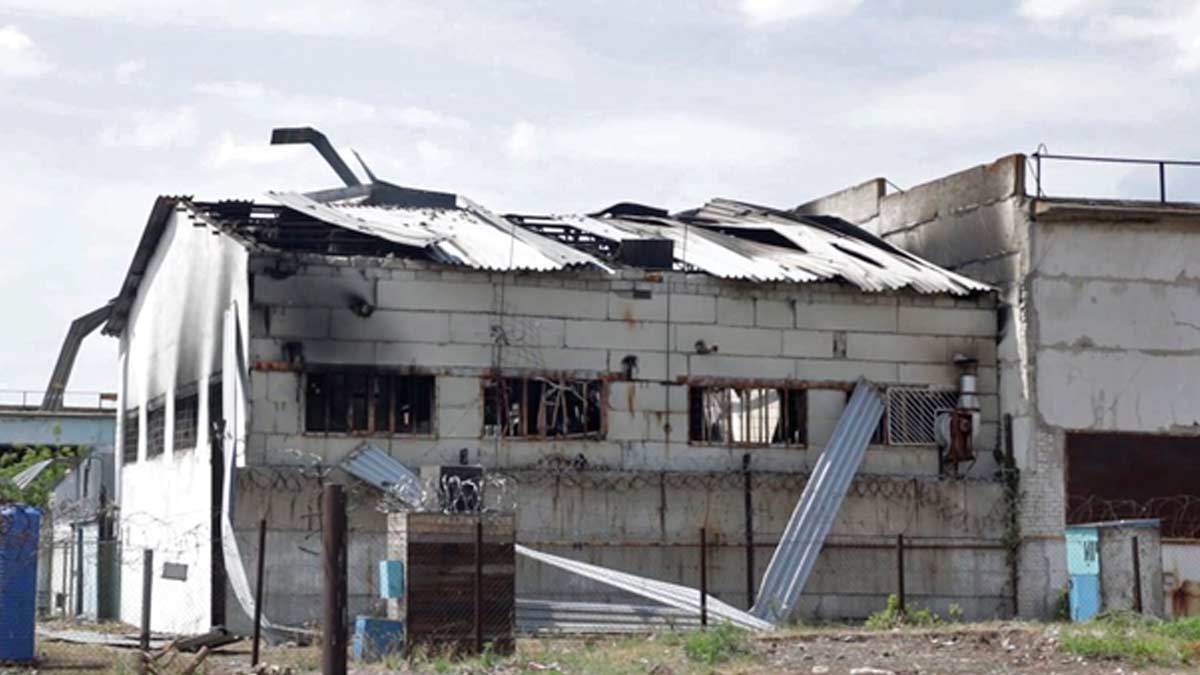
Editor’s Note: An earlier version of this story referenced the converted warehouse where POWs from the Azov Battalion were being kept in the northeast corner – that should have been northwest. Thank you for your understanding.
[UKRAINE] – (MTN) – On July 28, the self-declared leaders of the so-called Donetsk People’s Republic accused Ukraine of attacking the Olenivka Penal Colony, located 16 kilometers from the line of conflict. Over the span of 12 hours, Russian leaders, Russian state media, and unaffiliated pro-Russian journalists shared horrifying pictures, painting the Ukrainian armed forces as the executions of their people. The evidence they showed the world and their own casualty reports painted a different picture. One that potentially and accidentally documented in vivid detail the worst war crime against POWs in Europe since the Kosovo War in 1998.
The history of the Detention Camp 52
The dark history of Olenivka started in 2014 when the camp, situated in wheat fields and rolling hills just west of the village of Molodizhne, became a filtration camp for Crimean Tartars after the Russian occupation of the Crimea Peninsula. A 2015 United States Department of State annual report on Human Rights in Ukraine documented extrajudicial imprisonment and justice, torture, and executions. Conditions in the colony were squalid where disease ran rampant, and potable water was scarce.
After the Russia-Ukraine War started in February, Detention Camp 52, as it is officially known, took on a new role as a filtration camp for Ukrainian citizens in captured territory. During the siege of Mariupol, people who tried to leave the city went through a filtration process in the towns of Manush and Bezimenne. Many of those who were taken away for additional filtration ended up in Olenivka.
Women who went through filtration and were released reported being held in concentration camp conditions. They were held in areas so cramped they had to sleep sitting or, worse, in shifts. There was little heat, no blankets, and no beds. Disease was rampant, food was scarce, and drinking water was withheld, sometimes for more than a day. Hygiene products were barely provided, and female hygiene products were not to be found.
The world got its first look inside Olenivka in April when Russian state media and Pro-Russian social media accounts circulated pictures of alleged Ukrainian POWs from Mariupol. Our team analyzed and geolocated the videos. The video wasn’t recorded in Mariupol – it was recorded in Olenivka.
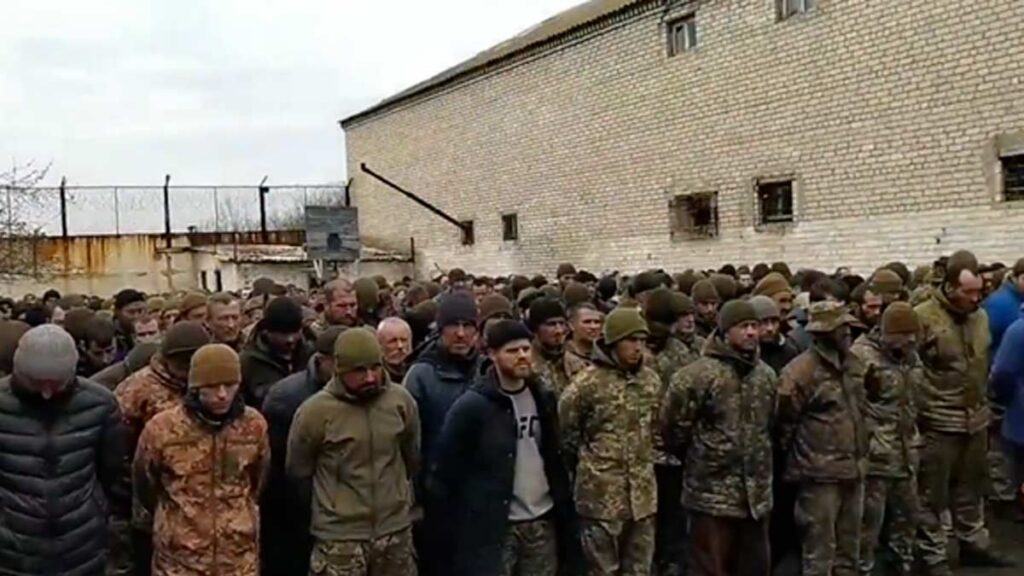
Editor’s Note: We have elected not to blur the faces of these prisoners in the hope that the continued sharing of their faces and identities can help keep them alive.
An analysis of the video showed only a few men in military uniforms moved to the front while the rest wore civilian clothing. Some of the men didn’t wear the uniforms of Ukraine but of Russian separatist militias. Most of the men did not resemble the numerous pictures from Russian state media and dark corners of Telegram showing dead Ukrainian soldiers who were mostly younger and more fit than their Russian conscript counterparts.
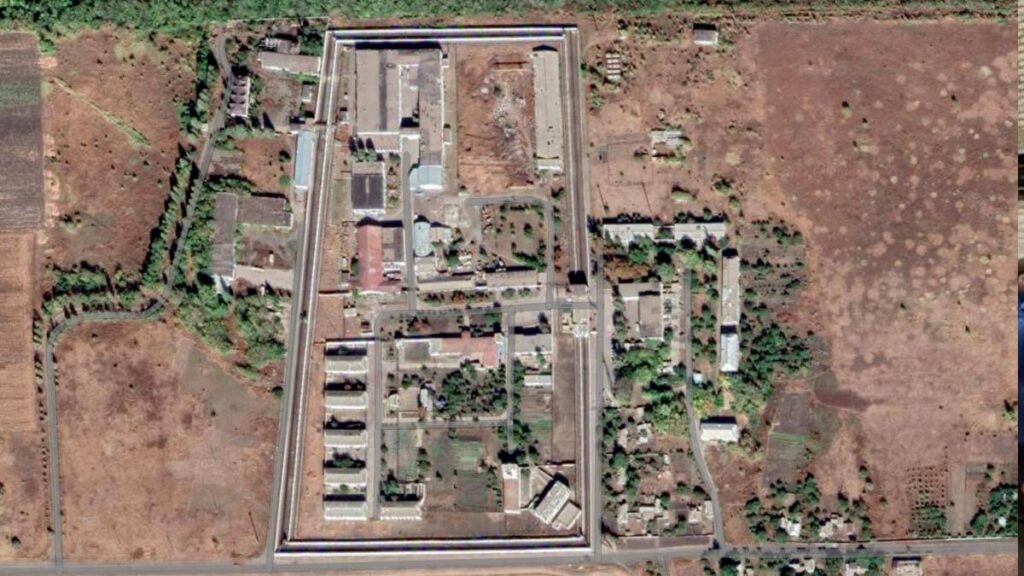
The penal colony is easily found on a map. The prison is double-walled and covers over 114,000 square meters. The perimeter is 1.5 kilometers with buildings for administration, guards, and worse surrounding the facility. In the northwest region, the warehouse that was partially converted into housing for prisoners of the Azov Battalion was still unused and had holes in its roof at the time of the Google satellite image.
From filtration camp to POW colony
On May 15, almost three months after the siege of Mariupol began and three weeks after Russia had declared victory within the port city, the Russian Ministry of Defense announced that a deal had been reached that would permit the safe surrender of the Ukrainian forces remaining inside the Azovstal Metallurgical Factory.
Confusion spread through the news channels as Pro-Russian social media accounts spread disinformation, and officials remained silent. Deputy Defense Minister of Ukraine, Anna Malyar, released a brief statement in the morning saying, “Thanks to the defenders of Mariupol, Ukraine gained critically important time. They fulfilled all their tasks. But it is impossible to unblock Azovstal by military means.”
Initially, the deal negotiated through United Nations and Red Cross intermediaries appeared to be a win for Ukraine and Russia. Ukraine found a way out for up to 2,200 marines, territorial guards, foreign volunteers, and local police. Russia was able to end its siege without having to storm the fortress that was Azovstal. It would take 7,000 to 10,000 troops to defeat the 2,200 remaining defenders, resulting in heavy losses. Russia’s offensive in Luhansk was bogged down, and they needed a way out.
On May 16, the first 264 Ukrainian troops left Azovstal and into Russian captivity. Among them were 53 seriously wounded soldiers that would face death without care from a hospital. Reporters from Russian state media and western media documented the evacuation and followed the convoy of hospital buses to Bezimenne. The other 211 soldiers faced an uncertain future as a convoy of five buses headed northeast to Olenivka.
On May 16, we wrote in our Situation Report, “The soldiers were likely taken to the infamous detention camp 52, between Olenivka and Molodizhne.” Video released by Russian state media on May 17, showed the convoy of busses arriving in the morning hours at the filtration center turned POW camp.
The deal that was brokered between Russia and Ukraine through the United Nations and Red Cross would facilitate a prisoner of war transfer. The Red Cross would be able to document the information on each prisoner, notify their family members, be a conduit of communication, and would monitor their care and treatment.
As the last of as many as 2,200 remaining soldiers, foreign volunteers, and police left the bunkers of Azovstal, the deal was already falling apart.
A history of war crimes
There were already rumors and whispers about the conditions within Detention Camp 52 as Mariupol POWs streamed in. The Red Cross never received its promised access, and multiple requests to inspect Olenivka and the prisoners were denied. Officials weren’t even permitted to document all of the prisoners that were removed from Azovstal, with a large discrepancy between the numbers claimed by the Russian Ministry of Defense and human rights observers.
Before the group from Mariupol arrived, the stories were consistent for the few who could leave the walls. Men taken to Olenivka fell into three groups.
For those found to be part of the military, the government, or had a prior history with the military or as a government employee, beatings, torture, and disappearances awaited. A release could be found through forced conscription for able-bodied men from 18 to 65 with no prior military or government connections and no pro-Ukrainian tattoos or ideation on digital devices. Those that refused faced deprivation, beatings, and torture until they disappeared or joined the Donetsk People’s Republic militia as forced conscripts. For the rest, slave labor in dangerous conditions awaited while living in squalid conditions without enough food and limited access to clean drinking water. The Red Cross and United Nations brokered a deal that committed POWs to concentration camp conditions.
On June 29, the Ukrainian Ministry of Defense announced that a prisoner swap had been arranged, and 144 POWs held at Olenivka were being exchanged for 144 Russian POWs. Among those released were 95 defenders from Azovstal and 43 members of the Azov Battalion. Pro-Russian social media erupted with outrage. Outside of the bots, troll farms, and the consumers of their social media content, hope emerged for more swaps on both sides. Despite the issues, it seemed possible that civility would prevail and that the stories were exaggerations. The hope was short-lived.
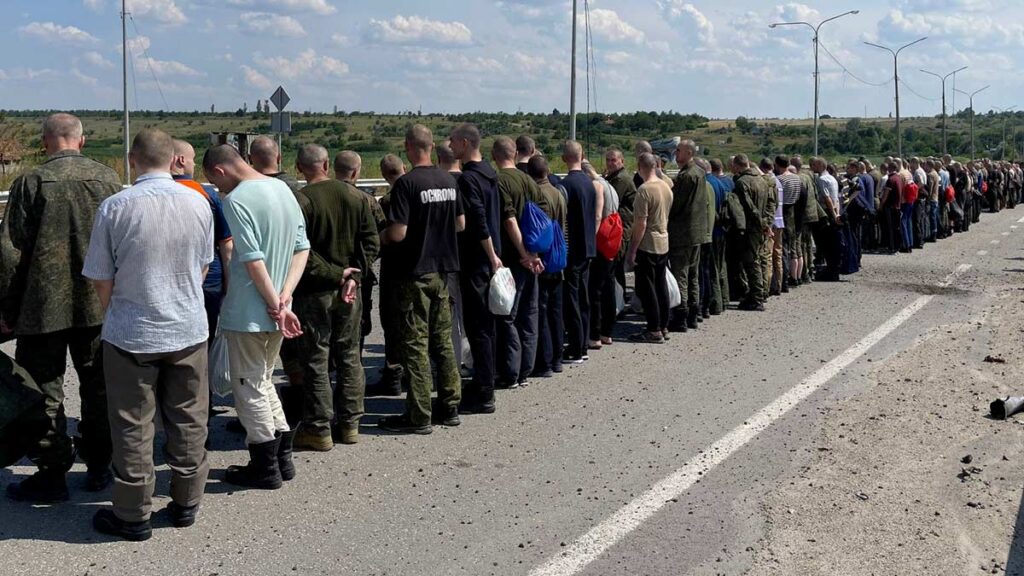
Many of those released were in poor health and were still healing from wounds now six weeks old. Some had to be taken away in ambulances. The Ukrainian government said that those released were getting the medical and psychological care they needed and asked for respect and privacy. Soon after their release, new whispers emerged within the medical community.
Beginning on July 8, our e-mail and social media inboxes became flooded with requests to validate reports that many of the soldiers released on June 29 had been castrated. On July 10, we made a public response that in order to confirm the reports, we would require first-person accounts from Ukraine with the cooperation of doctors and former POWs willing to go on the record. We would need access to medical records and permission from the Ukrainian government. We would need assistance and support from individuals trained to interview victims of torture and former prisoners in an ethical and respectful way.
We started working through our network to make that happen and planning a trip in late September or early October. On July 27, we received our forms from the Ukrainian government to get our press credentials. We wouldn’t need them. Hours later, the world had all the evidence it needed.
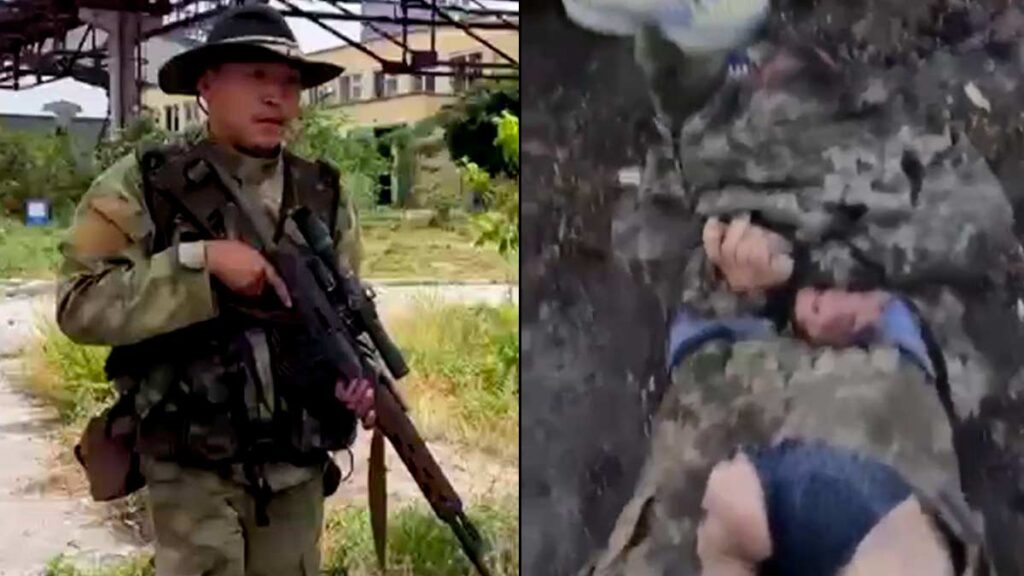
On July 28, a disturbing video emerged of a bound Ukrainian POW being castrated with a box cutter and then stomped on by a soldier in the Chechen Ahmat Unit, possibly in Severodoentsk, sometime in June. The POW was bound and restrained by multiple mercenaries and made blood-curdling screams as he was hacked for more than 45 seconds in the horrific video. After severing the genitals, the mercenary holds it up to the camera and tosses it on the ground by the man’s head. The video started circulating on Pro-Russian Telegram channels before spilling over to Twitter, YouTube, and others. The video has been deemed authentic, and the perpetrator in the video has been identified. A few hours later, a second part of the video emerged. The Ukrainian POW, who was likely already fatally wounded from his torture, was shot in the head at point-blank range.
The whispers of castration weren’t just rumors. They were unthinkably true.
A false flag to clean up a big mess
During the week of July 25, the leaders of Detention Camp 52 moved up to 200 members of the Azovstal Batallion to their own quarters. The area was walled off from the larger warehouse. It was a single room with a high ceiling and a corrugated metal roof. The building was brick and cinderblock construction.
PMC Wagner Group had at least one major problem, and possibly two. A squad recorded themselves torturing and executing a Ukrainian POW. The participants in the war crime wore surgical gloves, and the leader of the atrocity had a box cutter. In less than two minutes, they coordinated and moved in a way that indicated this was not the first time this had been done.
Worse, he was almost instantly identified because of his distinct clothing and the perpetrator appearing in earlier Russian state news reports, revealing distinguishing characteristics. Within 24 hours, the video had been validated by multiple sources, including our own team. The United Nations, European Union, and government officials condemned the action labeling it a war crime and a terrorist act.
Within the walls of Olenivka were there other prisoners who had been castrated, but instead of their testicles and penis removed to the prostate gland, only had their testicles cut off? The world will likely never know.
Hours after an undetermined explosion in the new barracks and Russian accusations of it being a HIMARS strike, the Ukrainian Directorate of Intelligence accused PMC Wagner Group of destroying the building. Local officials in Donetsk reported that 47 POWs had been killed and up to 130 wounded on July 28. Ukrainian intelligence claimed that the order to destroy the building came directly from Yevheny Prigozhin, the head of PMC Wagner Group.
There were reports that inspectors from the Russian Ministry of Defense were coming on September 1 to check on the conditions on Olenivka and do an audit of funds given to Wagner Group to expand the strained facilities.
In a statement on Telegram, Ukrainian Intelligence wrote, “The explosions in Olenivka are a deliberate provocation and an undeniable act of terrorism by the occupying forces side. According to the available information, they were carried out by mercenaries from the Wagner Group private military company (PMC) under the personal command of the nominal owner of the specified PMC, Yevheny Prigozhin.”
As the Kremlin and leaders of the self-declared Donetsk People’s Republic tried to turn the horror into a public relations coup, likely in an attempt to cripple western sanctions and arms support, the story quickly disintegrated. Not a single person with the Russian military, separatist militias, terrorists from the Imperial Legion, PMC Wagner Group, Chechen territorial guard, local territorial guard, or area police were injured or killed in the attack. No camp administrators or support staff were killed or wounded. The building, which held up to 200 POWs, was void of any guards or other authorities.
President Volodymyr Zelenskyy held a meeting with Ukrainian heads of staff and the Verkhovna Rada Commissioner of Human Rights regarding the terrorist attack in Olenivka, which was deliberately staged by Russian occupation forces. The Red Cross submitted a formal request to inspect the site and conduct an investigation.
The European Union condemned the incident, with EU foreign affairs chief Josep Borrell stating Russia’s actions constitute “severe breaches of the Geneva conventions and their Additional protocol and amount to war crimes.”
The Red Cross, which was supposed to have unfettered access as part of the May agreement, submitted a formal request to inspect the site and conduct an investigation. In a later statement, the Red Cross said it would conduct a full investigation if “all parties” would agree.
The evidence doesn’t support there was a rocket attack
Ukrainian officials have known about Olenivka since 2014. The camp, 16 kilometers from the line of conflict, has never been shelled since Russia annexed Crimea and separatists started fighting in February 2014. The settlements around the camp have also never come under artillery or rocket fire, nor have ever been bombed or attacked by aircraft. Our research team was aware of Detention Camp 52 by early March and was working on documenting and validating ongoing abuse claims.
We spoke with a former Gebirgspionier with the German Bundeswehr with explosives experience for their evaluation.
“It’s impossible that a HIMARS fired M30 or M31 warhead was used in the strike on the POW camp. No usual shrapnel pattern on the walls; they are almost virgin. Even the bodies don’t show shrapnel wounds but typical blast injuries. The roof is almost intact, which is near impossible for the corrugated metal roof material. The roof would have been blown almost entirely.
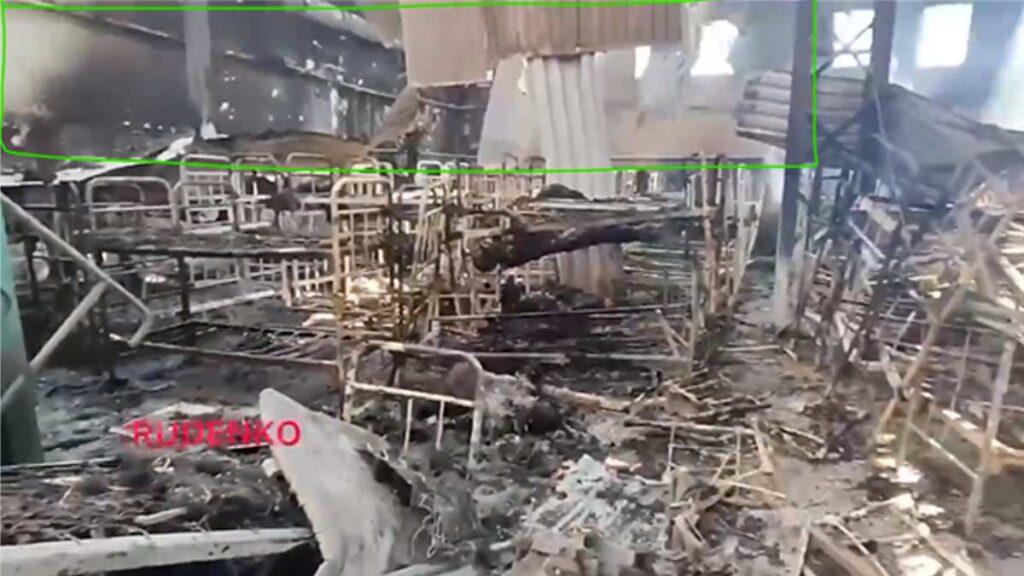
The bunk beds would have been expected to fall over and be torn apart, at least in the center of the blast radius. However, the burn marks on the walls and the spalling in their center remind me of directional charges (like one or two MON-90 hanging from or laying on the metal roof) attached to a gasoline canister. In my assessment, this caused the spalling on the wall: an impact of that metal canister where [an accelerant] splashed and formed those significant brand markings, as you would expect when searching a burned house for the source of a fire.”
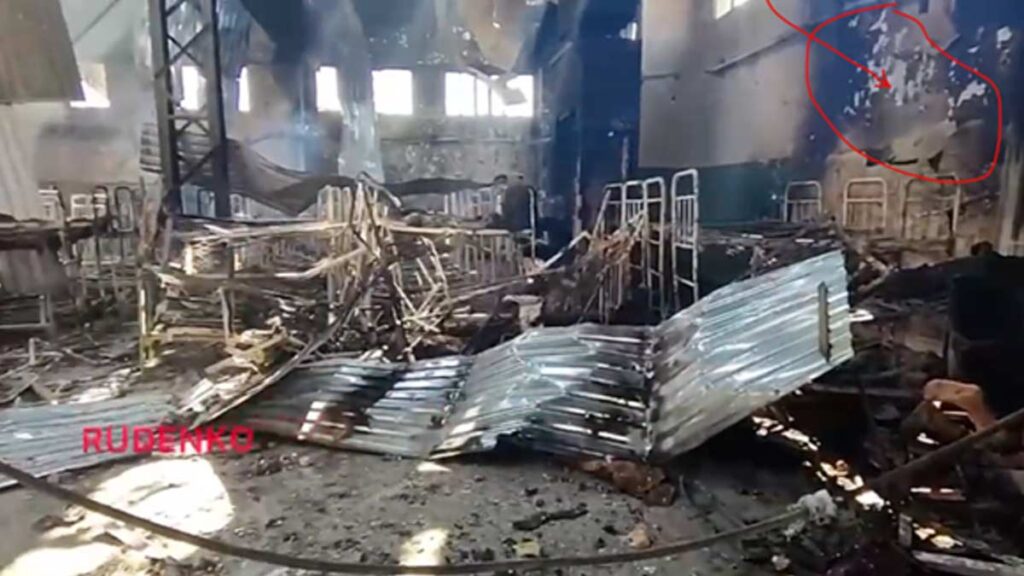
Photos from the exterior also do not support the claim of a rocket attack. The building has no shrapnel damage. The corrugated metal roof has been blown outward, not smashed down and blasted away. The blast damage and fire damage are all from the interior. Metal bars and window frames are not blown out but show damage consistent with an interior building fire.
The section of the building directly adjacent to where the Azovstal prisoners were held is also undamaged, with no blast damage through the concrete block wall.
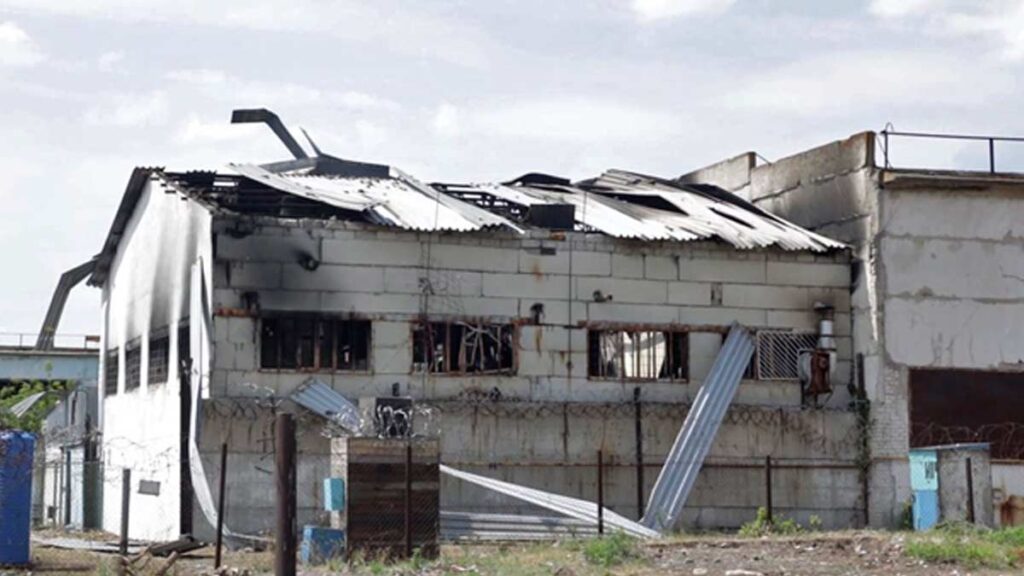
But the most damning evidence came from Russian state media and PMC Wagner Group. On July 27, a video circulated of a school in Izyum that had been converted into a military base after it had been attacked with rockets fired by HIMARS. That building was more soundly constructed than the Olenivka warehouse and had multiple interior rooms that would have contained the blast. The damage to the building doesn’t match the impact on the penal colony. The roof has been smashed from the top and blown out by the detonation. The building has been blown apart, with debris strewn in multiple directions. Whole window frames were blown out and lay meters away.
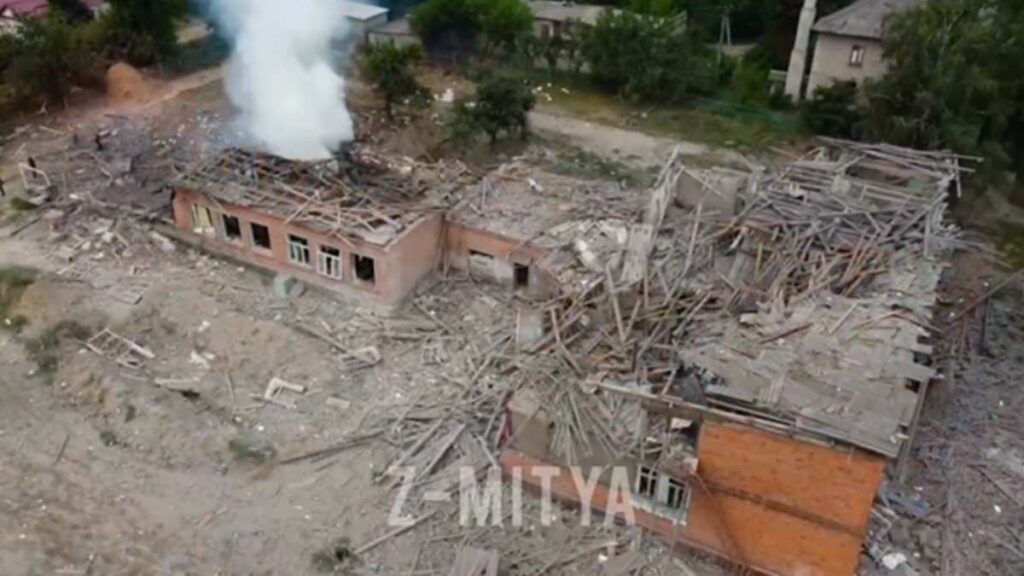
In another clumsy attempt to claim Ukraine committed a war crime by destroying a school, Wagner Group’s drone video showed trenches, tank scrapes, and firing positions on the school grounds and, from at least one point, still partially intact after the strike. The video also provided clear evidence of what a HIMARS strike looks like and the damage it causes.
Epilogue
Ultimately we cannot arbitrate if this was an interior or exterior explosion. That will have to be left to the experts and investigators. It is unlikely that third-party investigators will be allowed onto the scene until it was been sanitized and prepared more, if ever.
Was the building destroyed to cover up torture and mutilation? Was the explosion rigged to mass execute Azov Battalion members while painting Ukraine as the perpetrators to fracture western support? Was PMC Wagner Group covering up more war crimes and potential corruption?
One day, we may know. In war, the victor writes the history.








